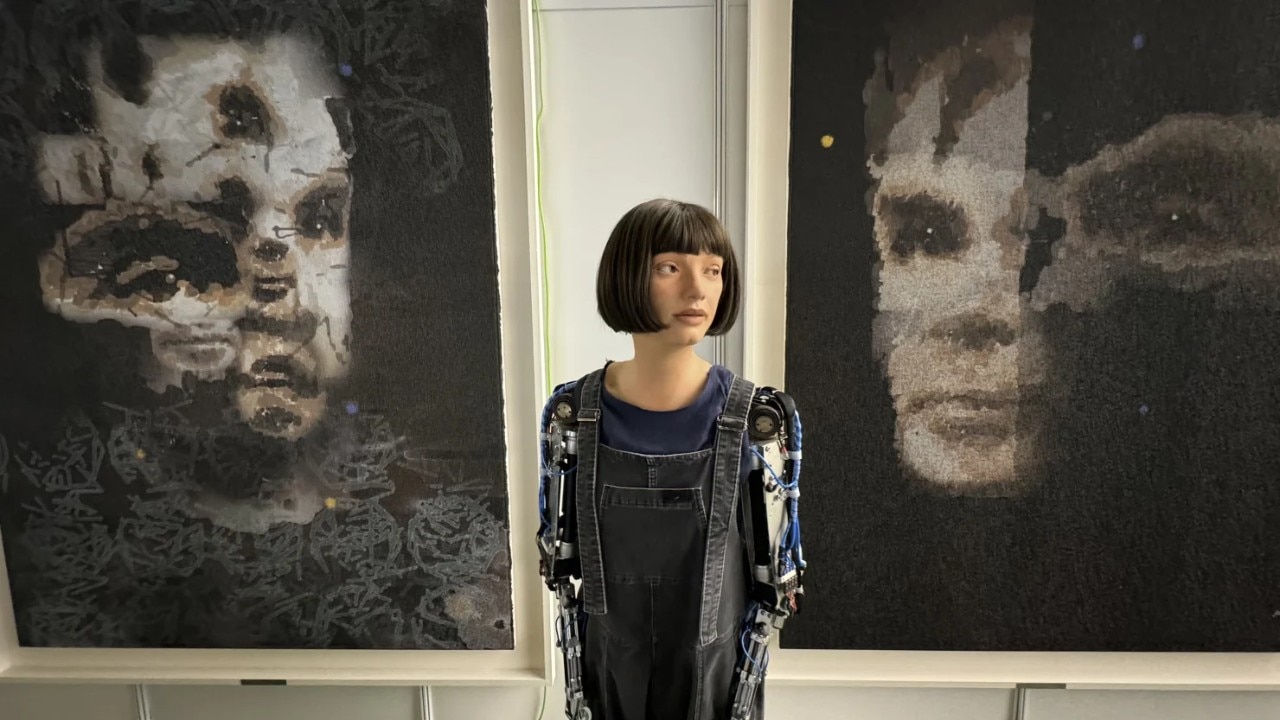humanoid robot guided by artificial intelligence. The piece, titled "A.I. God. Portrait of Alan Turing (2024)," is a portrait of the mathematician and computer scientist Alan Turing and is expected to lead the results of this Digital Art Day Auction in New York.
The artwork: A.I. God Portrait of Alan Turing
“AI God” stands 2.2 meters tall and is characterized by dark tones and color blotches forming an almost pixelated design that shapes an unrecognizable face. The fragmented face belongs to Alan Turing, a British mathematician, logician, cryptographer, and philosopher, considered one of the founding figures of computer science. Turing is known not only for cracking the Enigma codes during World War II but also for laying the theoretical groundwork for artificial intelligence.
“Turing raised questions about AI as early as the 1950s, and this artwork reflects those very concerns”, explains Aidan Meller, creative director and head of the Ai-Da Robot project, the humanoid responsible for the piece, who responded:
Through my portrait of Alan Turing, I celebrate his achievements and reflect on his concerns about artificial intelligence. My work aligns with the United Nations' vision of responsible AI use, an ideal that Turing himself championed.
Ai-Da: The Robot Artist
Ai-Da is a humanoid robot designed by a team of engineers and programmers from the universities of Oxford and Birmingham, with the aim of autonomously producing works of art. It uses cameras positioned in its eyes, artificial intelligence algorithms, and a robotic arm to draw and paint.
Its appearance resembles that of a young woman of Caucasian descent, with bangs and a bob haircut. The name Ai-Da is a play on words that combines a tribute to Ada Lovelace, the English mathematician who died at 36 in 1852 and was the first to envision applications of machines beyond simple calculations, the female name "Aida," and the acronym "AI," commonly used to refer to artificial intelligence. Interestingly, the name Ai-Da also echoes that of its creator, Aidan Meller, an expert in modern and contemporary art with over twenty years of experience in the field, who has been dedicated to the project for many years.
Just as Duchamp prevented us from viewing art in the same way, Ai-Da prevents us from seeing the artist and the human as we once did.
Aidan Meller
Ai-Da is not new to the art world: in 2019, she made her debut with the exhibition “Unsecured Futures” at the University of Oxford. In the same year, she conducted a workshop at Tate Modern in London, and in 2020, she participated in her first TEDx talk and exhibited her works in a United Nations show titled “WIPO: AI and IP, A Virtual Experience.”
Estimate and Value
The estimated value of the artwork is between $120,000 and $180,000, but expectations are definitely set higher. As the first piece created by a humanoid robot with artificial intelligence to go to auction, the symbolic value of "Ai God" could indeed increase its final price.
As a physical artwork with innovative value and conceptually accessible, “Ai God” could also attract more traditional collectors, who have remained skeptical even in the face of recent innovations like NFTs.
The enthusiasm and interest of collectors, combined with the importance of the artwork in the realm of artificial intelligence art, have directly influenced my decision to position the pre-sale estimate at a level that reflects its desirability and market potential.
Michael Bouhanna, vice president of Sotheby’s
But Ai-Da is certainly not the first: in 2020, the Ben Brown Fine Arts gallery in London presented "Dark Factory Portraits," a project in which a robotic arm named Heidi painted portraits of famous artists using acrylic paints. In 2019, at the Venice Biennale, the work "Can’t Help Myself" by Sun Yuan and Peng Yu featured a robotic arm cleaning a room of a blood-like red liquid, reflecting on themes of surveillance and control.
What is new, however, is the decision by one of the world's leading auction houses to put a similar artwork up for auction. This move raises questions about what creativity means and what can be considered a work of art. The answers remain yet to be discovered.

Accademia Tadini on Lake Iseo reborn with Isotec
Brianza Plastica's Isotec thermal insulation system played a key role in the restoration of Palazzo Tadini, a masterpiece of Lombard neoclassical architecture and a landmark of the art world.























